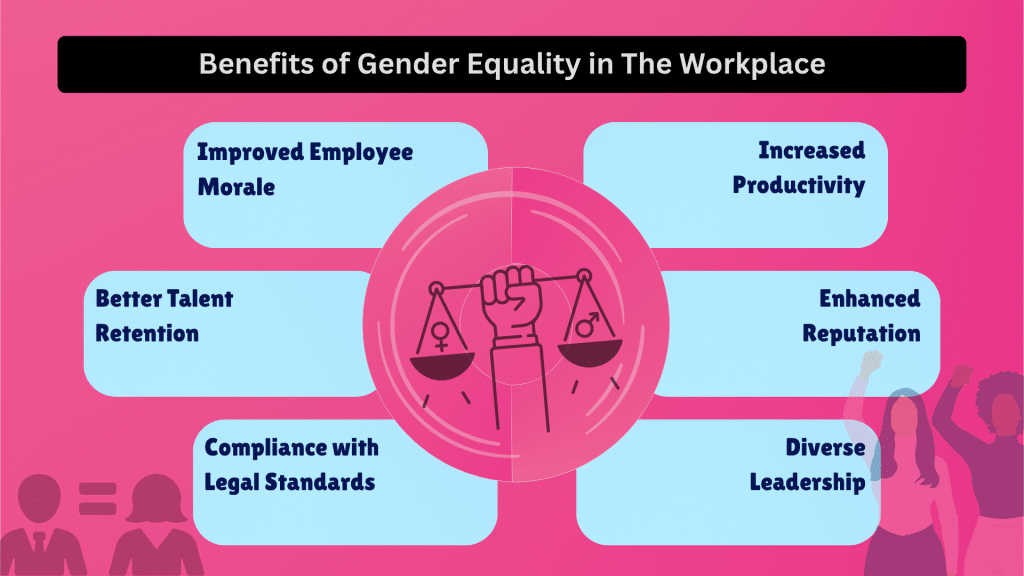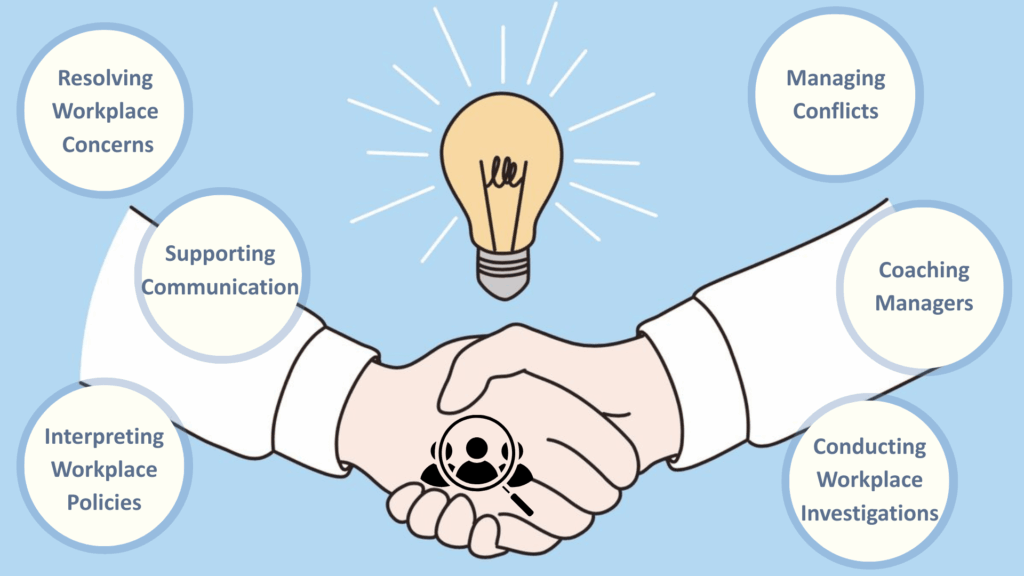Gender equality in the workplace has become a critical business priority across industries worldwide.
Organizations now recognize that creating equitable work environments extends beyond moral responsibility to deliver substantial strategic advantages through inclusive cultures.
This analysis examines the compelling business case for gender equality, identifies persistent challenges, and provides actionable strategies for employers building more equitable organizations.
We will discuss proven benefits, real-world implementations, and measurable approaches to creating lasting organizational change.
What is Gender Equality in the Workplace?
Gender Equality in the Workplace refers to the state where individuals of all genders have equal opportunities, treatment, and representation in employment settings.
In practical terms, it means that men, women, and non-binary employees should receive:
- Equal pay for equal work
- Fair hiring and promotion opportunities
- Access to leadership roles and professional development
- Protection from discrimination and harassment
- Equitable benefits and workplace policies
In the US, gender equality is supported by laws like:
- Title VII of the Civil Rights Act (1964) – prohibits gender-based discrimination in employment.
- Equal Pay Act (1963) – mandates equal pay for equal work regardless of gender.
- Pregnancy Discrimination Act (1978) – prevents discrimination based on pregnancy or childbirth.
- Family and Medical Leave Act (FMLA) – ensures leave rights for caregiving, supporting work-life balance.
Why Gender Equity Matters?

Gender equity represents a fundamental shift in how organizations approach fairness and opportunity in the workplace, moving beyond surface-level equality to address systemic barriers and individual needs.
- Beyond Equal Treatment: Gender equality provides the same resources to all, while gender equity addresses different challenges with varied support.
- Business and Social Impact: Organizations practicing equity see improved performance and innovation while addressing historical imbalances.
- Creating Equitable Systems: Equity approaches include flexible work, targeted mentorship, and compensation frameworks addressing systemic gaps.
A Human Rights Perspective on Gender Equality
Gender equality in the workplace extends beyond business benefits to fundamental human rights principles that form the foundation of ethical organizational practices.
1. Universal Rights and Dignity
The Universal Declaration of Human Rights establishes that all individuals deserve equal treatment and opportunities regardless of gender.
This perspective positions workplace gender equality as a moral imperative that transcends business considerations.
Organizations have ethical obligations to protect employee dignity and ensure fair treatment across all aspects of employment.
2. Legal Frameworks and International Standards
International labor standards, including those established by the International Labour Organization (ILO), provide comprehensive frameworks for gender equality in employment.
These standards cover equal pay, non-discrimination, maternity protection, and violence prevention.
Understanding these frameworks helps organizations align with global best practices and meet their human rights obligations.
3. Creating Rights-Based Cultures
A human rights approach requires organizations to view employees as rights holders rather than merely resources.
This perspective emphasizes empowerment, participation, and accountability in addressing gender inequality.
Companies adopting this approach typically demonstrate stronger long-term commitment to equality initiatives and more comprehensive policy frameworks.
Common Obstacles to Gender Equality in the Workplace
Despite recent progress, workplace gender equality still faces significant obstacles needing targeted interventions and systematic approaches to create meaningful change.
Organizations must systematically identify and address these persistent obstacles.
- Wage Gaps: Women earn 82 cents per dollar through occupational segregation and unconscious compensation bias
- Leadership Barriers: The “broken rung” phenomenon prevents women’s advancement despite higher education rates
- Systemic Bias: Implicit biases and outdated gender-neutral policies disadvantage certain groups
- Cultural Issues: Work-life balance challenges limit women with caregiving responsibilities
- Safety Concerns: Harassment creates unsafe environments requiring policy enforcement
Comprehensive Solutions to Gender Equality
Evidence-based interventions address root causes through strategic policy implementation.
- Fair Recruitment: Use diverse interview panels, standardized evaluation criteria, and remove gendered language
- Mentorship: Connect employees with leaders through mentorship programs and sponsorship relationships
- Pay Equity: Conduct pay audits and establish standardized pay bands with transparent criteria
- Flexible Work: Implement remote work and parental leave policies without advancement penalties
- Cultural Change: Build inclusive cultures through diversity training and zero-tolerance harassment policies
Business Benefits and Real-World Success Stories

Promoting gender equality in the workplace creates a fair, inclusive, and productive environment for all employees.
1. Improved Employee Morale
When workplaces ensure equal treatment and opportunities, employees feel valued and respected.
This leads to higher job satisfaction, stronger engagement, and a positive workplace culture where everyone is motivated to contribute their best.
2. Increased Productivity
Gender-diverse teams bring different perspectives and ideas, enhancing creativity and problem-solving.
This diversity in thought leads to better decision-making, innovative solutions, and overall higher organizational productivity, benefiting both employees and the company.
3. Better Talent Retention
Inclusive policies and fair treatment help employees feel secure and appreciated, reducing turnover.
When workers see equal growth opportunities and support, they are more likely to remain loyal, saving the company recruitment costs and preserving organizational knowledge.
4. Enhanced Reputation
Companies that prioritize gender equality earn respect from employees, clients, and the public.
A strong reputation for fairness and inclusivity makes it easier to attract top talent, build customer trust, and strengthen relationships with stakeholders.
5. Compliance with Legal Standards
Adhering to US gender equality laws, such as the Equal Pay Act and Title VII, protects organizations from discrimination lawsuits and regulatory penalties. Compliance also demonstrates ethical responsibility and supports a culture of fairness and accountability.
6. Diverse Leadership
Providing equal opportunities enables women and underrepresented genders to rise to leadership roles.
This diversity improves decision-making, broadens organizational perspectives, and fosters a culture where all employees see that advancement is achievable.
Gender Equality Group Discussion
Effective implementation of gender equality initiatives requires meaningful dialogue among stakeholders at all organizational levels to foster understanding and drive collective action.
1. Facilitating Productive Conversations:
Group discussions enable employees to share experiences, identify barriers, and collaborate on solutions while building psychological safety for open dialogue.
Regular forums help organizations gather diverse perspectives and develop more inclusive policies.
2. Key Discussion Topics:
Essential topics include unconscious bias recognition, inclusive leadership behaviors, career development opportunities, and work-life integration challenges.
Participants examine how organizational culture impacts different genders and identify specific equality-promoting actions.
These conversations reveal hidden barriers and generate innovative solutions.
3. Building Consensus and Commitment:
Successful discussions move beyond awareness to action planning by establishing shared success definitions, identifying accountable parties, and creating implementation timelines.
This collaborative approach ensures broader buy-in and increases the likelihood of sustainable change.
Conclusion
Remote work models and emerging AI technologies create new opportunities and challenges for gender equality.
Organizations must adapt their policies to prevent flexible arrangements from creating inequality while ensuring that AI tools reduce, rather than perpetuate, bias.
Gender equality delivers measurable business results: improved financial performance, innovation, engagement, and reduced legal risks.
Evidence-based strategies with sustained commitment produce meaningful progress and competitive advantages in talent acquisition and long-term success.
Ready to act?
Audit your policies, train leadership, set measurable goals, and get started today! Comment below and share your stories.
Frequently Asked Questions
How Long Does It Typically Take to See Results from Gender Equality Initiatives?
Most organizations begin seeing measurable improvements in employee satisfaction and engagement within 6-12 months. However, significant changes in leadership representation and pay equity can take 2-5 years, depending on company size and commitment level.
How Can Small Businesses with Limited Budgets Implement Gender Equality Initiatives?
Small businesses can start with cost-effective measures like reviewing job descriptions for biased language, implementing structured interview processes, conducting informal pay reviews, and establishing clear promotion criteria.
How Do you Measure the Roi of Gender Equality Investments?
Calculate ROI by comparing costs of initiatives against benefits like reduced turnover expenses, improved productivity metrics, decreased recruitment costs, and enhanced innovation outcomes. Many companies see positive returns within 18-24 months.










